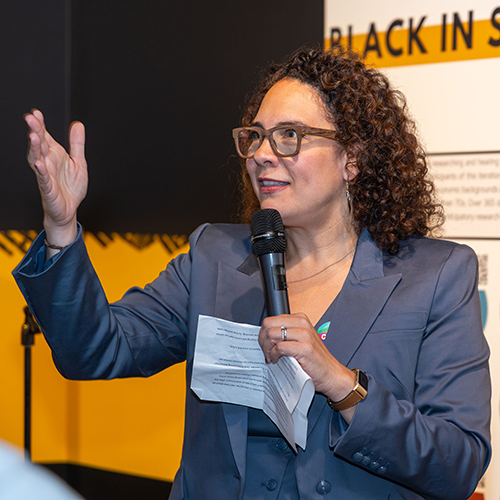In East Java, Indonesia, dancers are not always what they seem. Men present as women to perform female-style dance, and women gender bend for male-style dance. The performance of male- and female-style dances as cross-gender dances is particularly striking given Java’s Muslim majority.
Christina Sunardi, assistant professor of ethnomusicology in the School of Music, spent nearly two years conducting fieldwork in the regency of Malang in East Java, where she studied male- and female-style dances as well as the accompanying gamelan music. She also interviewed performers, participated in and attended performances, and spoke with audience members. Her book, Stunning Males and Powerful Females: Negotiating Gender and Tradition through East Javanese Dance (University of Illinois Press), is scheduled to be published in Autumn 2014.

“One of my aims has been to advance understandings of gender as a complex cultural construction that individuals actively negotiate,” says Sunardi, “and to complicate assumptions about what it means to be a man, a woman, or someone in-between in a Muslim-majority society.”
Sunardi explains that the performers she consulted were quite used to cross-gender dance. Many talked about males performing female roles in a type of theater called ludruk since the early twentieth century. One performer mentioned his grandmother performing a male-style dance called Beskalan Lanang during her heyday, which was likely from around the turn of the twentieth century to the 1940s. Other performers Sunardi interviewed recalled women performing the male-style dance NgremoLanang since the 1950s and 1960s.

What’s behind this tradition of gender-bending dance? "Cross-dressing in performance has had complex meanings in Java," says Sunardi, "such as symbolizing fertility through the combination of male and female elements." More worldly concerns may also have played a role in cross-gender performances. Performers Sunardi interviewed speculate thatludruk theater, which involved troupes traveling around the region, had been all male in part because it would have been inappropriate for women to travel with men. As for females taking male roles at the time of her fieldwork, Sunardi offers two possible explanations: necessity—because more girls were interested in studying certain dance forms than boys—and a means of female empowerment.
Sunardi found that some men gravitate toward female-style dance because of their own blurring of gender roles in their daily lives. “One male dancer talked about having a woman’s heart and a naturally high voice,” recalls Sunardi. “He felt that was one reason he was suited to female-style dance and female roles in ludruk, though he lived his life as a man. Some males who specialize in female roles in ludruk live as waria, or males who dress and live as female.”
In contrast, the women Sunardi consulted who dance male-style dances “did not live as male and did not talk about having men’s hearts,” says Sunardi. “I posit that they were performing male-style dance to show that they can be powerful women.”

That such gender exploration can take place in a Muslim-majority country might surprise some, given that Islam frowns upon assuming the characteristics of the opposite gender. Yet most of the cross-gender performers—and their audiences—identify as Muslim. “Islam is flexible,” Sunardi explains. “People make sense of it in their own way. Most people in Indonesia are open-minded.”
Ludruk’s popularity appears to have declined recently, in part due to an abundance of entertainment options in the 21st century and in part due to the expense of its massive cast. But other cross-gender dances, particularly those featuring women performing male-style roles, remain popular.
“One of the goals of my book is to explore how performers have made changes to their dance traditions, and how, in so doing, they have made changes to the way gender is represented and embodied,” says Sunardi. “Sometimes performers reinforce dominant norms and sometimes performers subvert them. Sometimes they do both at the same time. It’s been fascinating to see how these dances have evolved. I’ve come to realize that even if a dance is considered ‘traditional,’ it’s continuously undergoing change.”
Christina Sunardi will speak about “Complicating Gender and Islam through Performance in East Java, Indonesia” as part of the School of Drama’s Performing Arts Lecture Series. The lecture will be held October 29 at 7:30 pm in the Glenn Hughes Penthouse Theatre. For more information or tickets, visit the event website.
More Stories

A Statistician Weighs in on AI
Statistics professor Zaid Harchaoui, working at the intersection of statistics and computing, explores what AI models do well, where they fall short, and why.

The Mystery of Sugar — in Cellular Processes
Nick Riley's chemistry research aims to understand cellular processes involving sugars, which could one day lead to advances in treating a range of diseases.

Interrupting Privilege Starts with Listening
Personal stories are integral to Interrupting Privilege, a UW program that leans into difficult intergenerational discussions about race and privilege.